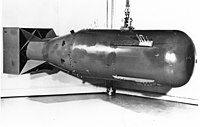
Photo from wikipedia
Abstract Limited knowledge of how ozonation affects algal organic matter (AOM) character and removal hinders assessing the suitability of ozonation for treating AOM-laden waters. This study examines pre-ozonation-coagulation and coagulation-post-ozonation… Click to show full abstract
Abstract Limited knowledge of how ozonation affects algal organic matter (AOM) character and removal hinders assessing the suitability of ozonation for treating AOM-laden waters. This study examines pre-ozonation-coagulation and coagulation-post-ozonation of AOM, specifically its non-proteinaceous fraction (NP). O3 doses of 0.05–4.0 mg per 5 mg dissolved organic carbon were applied at pH 5.5, 7.8, and 9.0; coagulation was performed in pH range 5.0–9.0. Coagulation alone exhibited maximum removal of 15%, and pre-ozonation before coagulation had different impacts depending on both the O3 dose and ozonation pH. In case of pH 5.5 and 7.8, the lowest and highest O3 doses improved the removal (by max. 7%); by contrast, the medium O3 dose deteriorated coagulation. In case of pH 9.0, at which different oxidation pathways predominate, the low and medium O3 doses had negligible effects, while the highest O3 dose improved NP removal (by max. 11%). Noteworthy is that despite these trends appeared throughout the whole coagulation pH range, NP removal depended also on coagulation pH. Post-ozonation after coagulation contributed to NP removal (additional 5–6%) at the highest O3 dose. In general, positive effects of ozonation were ascribed to charge alterations and partial mineralization of NP, adverse effects to changes in molecular weights. Additionally, aldehydes (up to 34.2 μg mg-1 DOC; predominantly formaldehyde and acetaldehyde) were formed whenever ozonation was involved, more with increasing O3 dose, and regardless the ozonation pH. The results emphasize the importance of optimizing ozonation so as to reach the benefits and avoid the undesirable effects on water quality.
Journal Title: Journal of environmental chemical engineering
Year Published: 2020
Link to full text (if available)
Share on Social Media: Sign Up to like & get
recommendations!